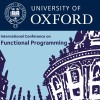Super 8 Languages for Making Movies (Functional Pearl)
Co-written by Stephen Chang (Northeastern University, USA) and Matthias Felleisen (Northeastern University, USA).
The Racket doctrine tells developers to narrow the gap between the terminology of a problem domain and general programming constructs by creating languages instead of just plain programs. This pearl illustrates this point with the creation of a relatively simple domain-specific language for editing videos. To produce the video proceedings of a conference, for example, video professionals traditionally use 'non-linear' GUI editors to manually edit each talk, despite the repetitive nature of the process. As it turns out, video editing naturally splits the work into a declarative phase and an imperative rendering phase at the end. Hence it is natural to create a functional-declarative language for the first phase, which reduces a lot of manual labor. This user-facing DSL utilizes a second, internal DSL to implement the second phase, which is an interface to a general, low-level C library. Finally, we inject type checking into our language via another DSL that supports programming in the language of type formalisms. In short, the development of the video editing language cleanly demonstrates how the Racket doctrine naturally leads to the creation of language hierarchies, analogous to the hierarchies of modules found in conventional functional languages.




